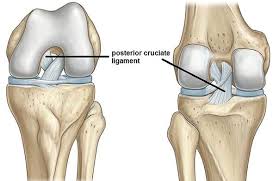Posterior Cruciate Ligament (PCL) Injury – Conservative Recovery with Physiotherapy
Introduction
The PCL is less commonly injured than the ACL but can still lead to knee
instability. Physiotherapy is the primary treatment in most PCL cases, helping
avoid surgery.
What Is a PCL Injury?
The PCL connects the femur to the tibia and prevents backward shifting of the
shin. It is injured in trauma or sports.
Causes
● Dashboard injuries (car accidents)
● Falling on a bent knee
● Hyperextension injuries
Symptoms
● Pain and swelling
● Difficulty in walking downhill or stairs
● Instability and stiffness
● Bruising around the knee
Diagnosis
● Physical tests (posterior drawer)
● MRI scan
💠 Physiotherapy Treatment for PCL Injury
💠 Phase 1: Acute Phase (Week 0–3)
● Bracing to prevent posterior tibial translation
● Pain management: TENS, cold packs
● Non-weight bearing exercises: Ankle pumps, quad sets
● Gentle ROM: Under supervision
💠 Phase 2: Strength and Mobility (Week 3–6)
● Straight leg raises, hip bridges, side-lying abductions
● Avoid open-chain hamstring exercises early
● Closed chain activities: Half squats, step-ups
● Partial weight bearing with gait training
💠 Phase 3: Return to Function (Week 6–12+)
● Proprioception training: Bosu ball, single leg stance
● Core and hip strengthening
● Sport-specific retraining
● Plyometrics (if athlete)
Conclusion
With a personalized plan from Pure Physio’s home physiotherapists in
Delhi and Faridabad, patients can regain full function without surgical
intervention.

